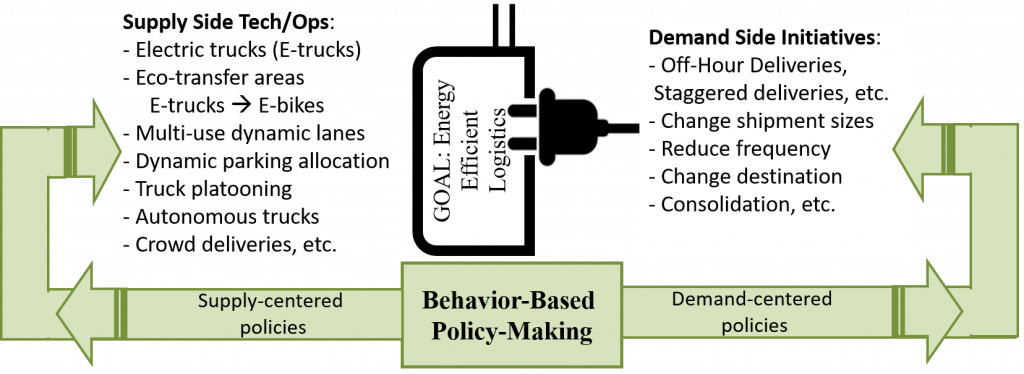Collaborative Public-Private Sector Approaches to Foster Energy Efficient Logistics in the NYC-Albany Corridor
START YEAR: 2017
COMPLETION YEAR: 2022 (estimated)
PRIMARY CONTACTS:
- José Holguín-Veras,
- Jeffrey Wojtowicz
RESEARCH PARTNERS:
- Argonne National Laboratory
- George Mason University
SPONSORS/FUNDING:
- US Department of Energy

OVERVIEW
Rensselaer Polytechnic Institute (RPI) is leading the “Energy Efficient Logistics: Behavior-Based Policymaking at NYC-Albany Corridor” in collaboration with Argonne National Laboratory, George Mason University and multiple public and private sector organizations operating in the Albany and NYC regions. This project would be led by Dr. Jose Holguin-Veras at RPI. This proposed living lab will: (1) fully exploit behavior-based policymaking approach developed by the team during the NYC Off-Hours Delivery project to reduce the energy consumption of freight activity; (2) design and pilot test Energy Efficient Logistics (EEL) initiatives to simultaneously reduce energy use and emissions, increase profits, and improve quality of life. This high priority work will focus on the vital, yet often neglected, freight sector, with an innovative approach that will yield significant reductions in energy use. A powerful feature of the behavior-based policymaking approach is its business friendly nature. The private sector will be an ally.
KEY FINDINGS
- Results from an online survey, implemented by the team on June 2019 to more than 500 frequent e-commerce shoppers, show how delivery lockers and delivery consolidation (delivering multiple orders at the same time) are the strategies with the most acceptance among shoppers to improve sustainability of e-commerce deliveries.
- Traffic simulations show that if ports extended their working hours and stagger the arrival of freight vehicles coming to load and unload, there would be a reduction in fuel consumption to all the vehicles that travel through the area of the port.
- Analysis of an extensive GPS data base of freight vehicles show that vehicles traveling in the New York City metro area emit more pollutants per mile traveled than in the corridor or Capital District. Between, the three geographical areas, the Capital District is the area where freight vehicle are less pollutant.
- A new energy efficiency framework was designed to consider the unique aspects of logistics. Six determinants were identified as key
factors for characterizing energy efficiency. (1) Network level efficiency, (2) demand level efficiency, (3) mode/vehicle choice efficiency,(4) routing efficiency, (5) traffic and/or driving efficiency and (6) vehicle efficiency. - Synergy between energy efficiency logistic initiatives can be exploited to exacerbate the potential benefits each initiative has while reducing the adverse effects. For example, a combination of Off-Hour Deliveries (OHD) with electric vehicles is ideal because noise pollution concerns of OHD are reduced with the usage of electric vehicles. At the same time, operational concerns of electric trucks diminish in the off-hours where delivery routes are shorter and more efficient. A virtuous cycle among energy efficiency strategies is the preferred outcome.
- A Behavioral Microsimulation that models all freight vehicle activity in the Capital District indicate that locating distribution centers closer to the core of the metropolitan area generates less vehicle miles traveled than locating them in the outskirts of the area.
For detailed information about the tasks of the project click on the following links:
- Catalog of Initiatives and Energy-Efficiency Framework
- Behavioral Microsimulation (BMS)
- Port Simulation
- Baseline Conditions of Emissions and Fuel Consumption
- Behavioral Modeling
RELATED PROJECTS
- Off-Hour Delivery Program
